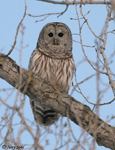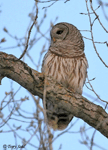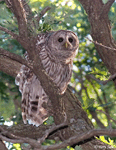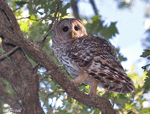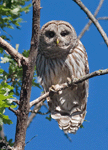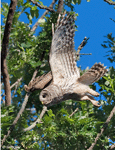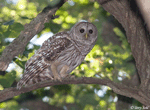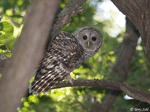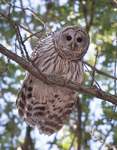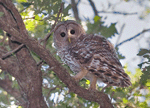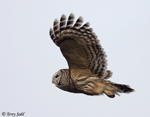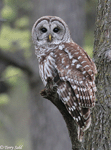| Length: 20 - 24 inches | Wingspan: 60 inches | Seasonality: All Seasons |
| ID Keys: No ear tufts, dark eyes, horizontal barring on chest, vertical stripes on the belly | ||
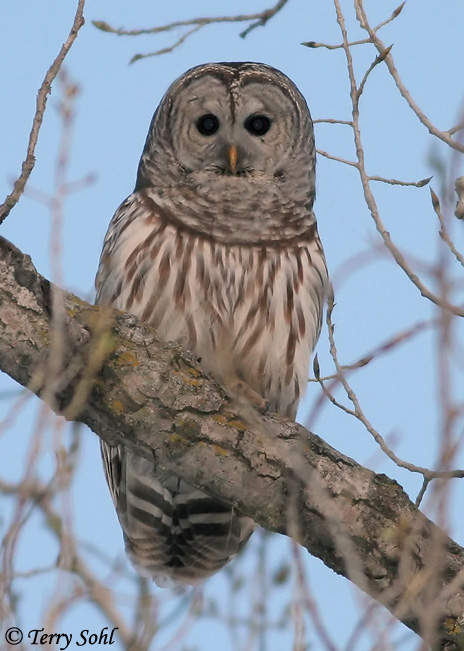 The Barred Owl is what is
commonly referred to as the "Hoot Owl" in the southeastern United
States, as its deep hoots are common sounds in the thick forests of the
region. While primarily nocturnal, they are sometimes actively hunting
during daylight hours. They are nearly as large as the Great
Horned Owl, but are generally much less aggressive and unable to directly
compete with them. In South Dakota, they are rare and local, with most sightings
in the extreme southeastern part of the state.
The Barred Owl is what is
commonly referred to as the "Hoot Owl" in the southeastern United
States, as its deep hoots are common sounds in the thick forests of the
region. While primarily nocturnal, they are sometimes actively hunting
during daylight hours. They are nearly as large as the Great
Horned Owl, but are generally much less aggressive and unable to directly
compete with them. In South Dakota, they are rare and local, with most sightings
in the extreme southeastern part of the state.
Habitat: Prefers dense woodlands with just a few scattered clearings. Much of the time they are found in low-lying, swampy environments. In the eastern United States, they are most often found in deciduous forests, but in the northern and western parts of their range, can also be found in coniferous forest.
Diet: Primarily feeds on small mammals such as mice and shrews, as well as larger mammals including rabbits, squirrels, and opossums. They will also eat a variety of birds, lizards, snakes, frogs and toads, salamanders, and large insects. Birds near aquatic environments will also consume fish and crustaceans.
Behavior: Often most active at dawn and dusk, but may hunt at any time of day or night. Hunts by either searching from a high perch, or by flying low through the forest in search of prey. Paired birds will often call to each other.
Nesting: The nest of a Barred Owl is in a large cavity in a tree, or sometimes in an old hawk or crow nest. The female lays 2 or 3 eggs, and she does most of the incubating. When the young hatch, the male typically does most of the hunting at first while the female stays with the young. The young typically fledge after about 6 weeks.
Interactive eBird Map: Click to access an interactive eBird map of Barred Owl sightings
Song: Barred Owl Song
Migration: Generally a permanent resident throughout their range.
Similar Species: Spotted Owl (not found in South Dakota), Great Gray Owl
Conservation Status: Barred Owls are still common and widespread in much of their normal range, but they have declined locally where swamp habitat has been destroyed. However, in recent decades they have expanded their range in western Canada and the Northwest U.S. In these areas, they have begun to compete with the Spotted Owl, and have also hybridized with them. Overall, populations are not threatened, and the IUCN lists the Barred Owl as a species of "Least Concern".
Further Information: 1) USGS Patuxent Bird Identification InfoCenter, Barred Owl
Photo Information: April 22nd, 2008 - Newton Hills State Park, South Dakota - Terry Sohl
Additional Photos: Click on the image chips or text links below for additional, higher-resolution Barred Owl photos.
| Click on the map below for a higher-resolution view |
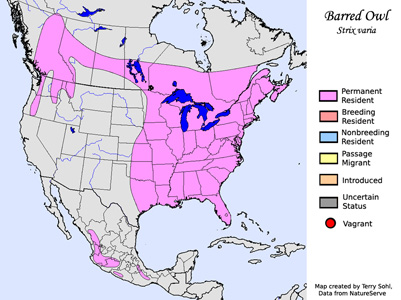 |
| South Dakota Status: According to the SDOU's latest version of "Birds of South Dakota", Barred Owls are just rare visitors in the southeastern corner of the state, and accidental elsewhere. However, the bird in the photo above was paired with another bird in the spring of 2008, and were observed in courtship behavior. |
Additional Barred Owl Photos
Click for a higher-resolution version of these photos
